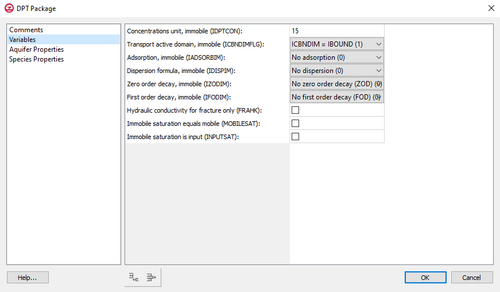GMS:DPT Package
| This contains information about functionality available starting at GMS version 10.4. The content may not apply to other versions. |
The Dual Porosity Transport (DPT) package is used for solutions to contaminant transportation in a steady state or transient flow field in the immobile domain of the dual porosity system.
The DPT Package dialog is divided into two parts: one on the left which shows the main sections, and one on the right which shows the inputs for the current section.
Comments
Comment lines can be added and will appear at the top of the DPT file. Use the Add Row ![]() button to create comments. Comments can be removed using the Delete Row
button to create comments. Comments can be removed using the Delete Row ![]() button.
button.
Variables
Variables corresponding to item 1a in the DPT input file.
- Concentration unit, immobile (IDPTCON)
- Transport active domain, immobile (ICBNDIMFLG)
- Adsorption, immobile (IADSORBIM)
- Dispersion formula, immobile (IDISPM)
- Zero order decay, immobile (IZODIM)
- First order decay, immobile (IFODIM)
- Hydraulic conductivity for fracture only (FRAHK)
- Immobile saturation equals mobile (MOBILESAT)
- Immobile saturation is input (INPUTSAT)
Aquifer Properties
Cell-by-cell inputs independent of species such as porosity. The table in this section contains four columns.
- Property Name – This column lists all of the available parameter types. The following parameters are available:
- PHF – The fraction of the total space that is occupied by the mobile domain.
- PRSITYIM – The effective transport porosity of the immobile domain.
- BULKDIM – The bulk density of the porous matrix of the immobile domain.
- DLIM – The longitudinal dispersivity coefficient for transport between mobile and immobile domains.
- DDTTR – The mass transfer coefficient for diffusive transport between mobile and immobile domains.
- SIM – The saturation in the immobile domain inputted when dual domain flow is not solved.
- Use Constant – Checking on this option indicates a constant value will be used for the parameter instead of an array.
- Constant Value – A value that will be used for the parameter if an array is not being used.
- Array Editor – Clicking the Edit button will open the array editor dialog where array values can be entered.
Species Properties
Cell-by-cell inputs that depend on the species, such as adsorption. The table in this section contains five columns.
- Species ID – Lists the species ID corresponding to the species name in the Species section.
- Property Name – – This column lists all of the available properties for each species. The following species properties are available:
- ADSORB – Adsorption.
- FLICH
- ZODRW
- ZODRS
- FODRW
- FODRS
- CONC – Concentration.
- Use Constant – Checking on this option indicates a constant value will be used for the parameter instead of an array.
- Constant Value – A value that will be used for the parameter if an array is not being used.
- Array Editor – Clicking the Edit button will open the array editor dialog where array values can be entered.
GMS – Groundwater Modeling System | ||
|---|---|---|
| Modules: | 2D Grid • 2D Mesh • 2D Scatter Point • 3D Grid • 3D Mesh • 3D Scatter Point • Boreholes • GIS • Map • Solid • TINs • UGrids | |
| Models: | FEFLOW • FEMWATER • HydroGeoSphere • MODAEM • MODFLOW • MODPATH • mod-PATH3DU • MT3DMS • MT3D-USGS • PEST • PHT3D • RT3D • SEAM3D • SEAWAT • SEEP2D • T-PROGS • ZONEBUDGET | |
| Aquaveo | ||
